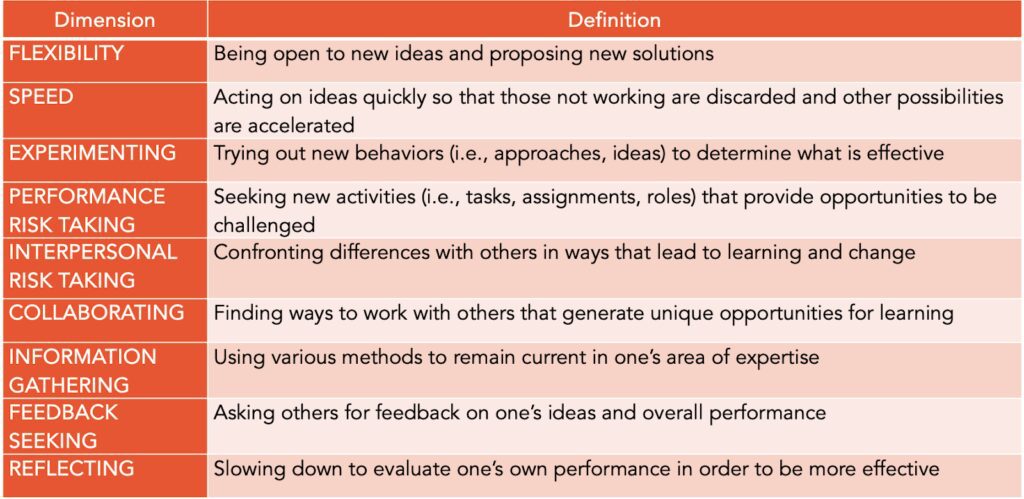If the past decade has taught us anything, it’s that crises are no longer occasional disruptions but persistent challenges, and the coming year will likely serve to underscore this new reality. Organizations that thrive are those that continuously adapt, learn, and innovate. Here are five strategies to adopt now to thrive — rather than flounder — through the next crisis.
1. Foster a Learning Organization
At the heart of resilience lies the ability to learn and grow. As defined by Peter Senge, a learning organization is one where people continually expand their capacity to achieve the results they truly desire, nurture expansive patterns of thinking, and work collectively toward shared aspirations.
But learning doesn’t stop with individuals. Instead, it must scale across teams and the entire organization. This requires specific characteristics for learning agility, as validated in research by W. Warner Burke. Among them include:

Learning agility is defined by Dr. W. Warner Burke as the ability to navigate new experiences by experimenting, seeking feedback, and adapting quickly. In his words, “what you do when you don’t know what to do.” Companies that build this capacity will be better equipped to face crises head-on.
2. Develop Super-Capabilities
Not all capabilities are created equal. Prioritizing three “super-capabilities” will have an outsized impact:
First, there’s partnership, which is demonstrated by those who can form, develop, maintain, and optimize formal and informal relationships for mutual benefit. This includes connecting their network as needed and bringing the right combination of people together.
Second, change leadership is about setting conditions for successful change, including communicating compelling visions that inspire people, productively engaging and motivating them throughout change, addressing resistance and implementing enablers for change, and capitalizing on momentum to sustain change for as long as it’s needed. This is especially needed in disruptive times.
And third, strategic follow-through is the ability to anticipate and act with the understanding of the whole in totality, the contribution of each of its parts, and how they interact (or could) in the past, present, and potential futures.
Super-capabilities aren’t just individual traits. They are organizational strengths that shape how companies respond to challenges. To build them, they must be practiced on an ongoing basis.
3. Engage Your People
In a crisis, some might think that the opposite of high engagement is low engagement. It makes sense, but in reality, a total lack of engagement is apathy. Now, tie that to a crisis or challenge, and you’ll see why you need engagement. Engagement happens when people are motivated to contribute and connect above and beyond. To foster this:
- Use dialogue and collaboration to build trust.
- Create a dynamic environment where knowledge is constantly shared and synthesized.
Engaged employees are not just participants but innovators, problem-solvers, and advocates for change. Without engagement, even the best strategies may falter.
4. Embrace Co-Design for Innovation
Innovation is often seen as the result of isolated genius, but true innovation happens through co-design. By involving the very people expected to implement changes in the design process, organizations create solutions that are desirable, viable, and feasible. The process includes:
- Research and Ideation: A deep understanding of the needs and exploration of possibilities.
- Prototyping: Test and refine solutions iteratively.
Co-design fosters trust, accelerates buy-in, and ensures that innovations are grounded in real-world needs.
5. Implement Disciplined Change
Change is the bridge between innovation and adoption. To ensure that changes stick, organizations need a disciplined approach:
- Plan and Implement: Establish clear objectives and actionable steps.
- Manage and Measure: Monitor progress and adapt as needed.
- Sustain: Embed changes into the culture to create a lasting impact.
The key is intentionality. Change must be thoughtfully designed and managed to transform crises into opportunities.
The combination of design and change processes is the basis for the Design of Work Experience Framework (DOWE), which incorporates the development and use of capabilities and engagement throughout. The book Culture Your Culture: Innovating Experiences @Work uses this framework as the “how to” for culture, but there are many additional use cases for the approach.
Continuous Preparation: The Key to Sustainability
Preparation for the next crisis doesn’t begin when the crisis hits. It starts now. Organizations must establish a baseline, assess their readiness, and build the learning, capabilities, and engagement needed to thrive in any scenario.
Incorporating these five strategies will not only prepare your company for future crises but also position it as a leader in innovation, resilience, and transformation. By fostering a culture of continuous learning and disciplined execution, you can navigate uncertainty with confidence.
Are you ready to face the future? The time to prepare is now.

